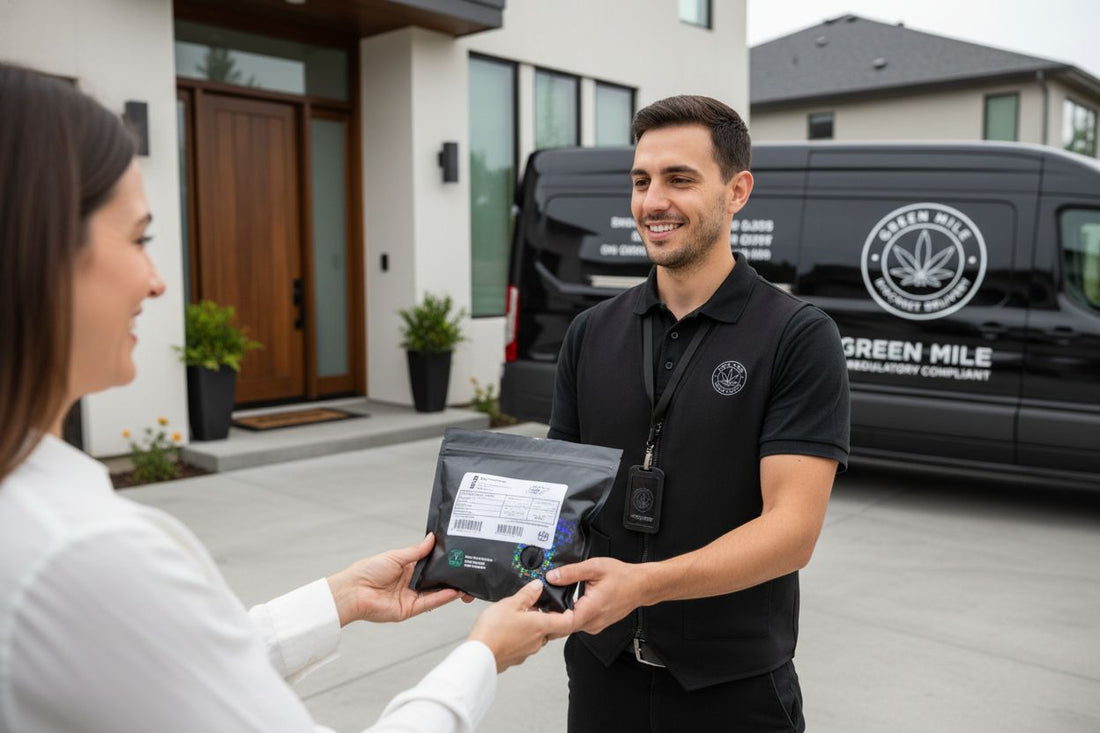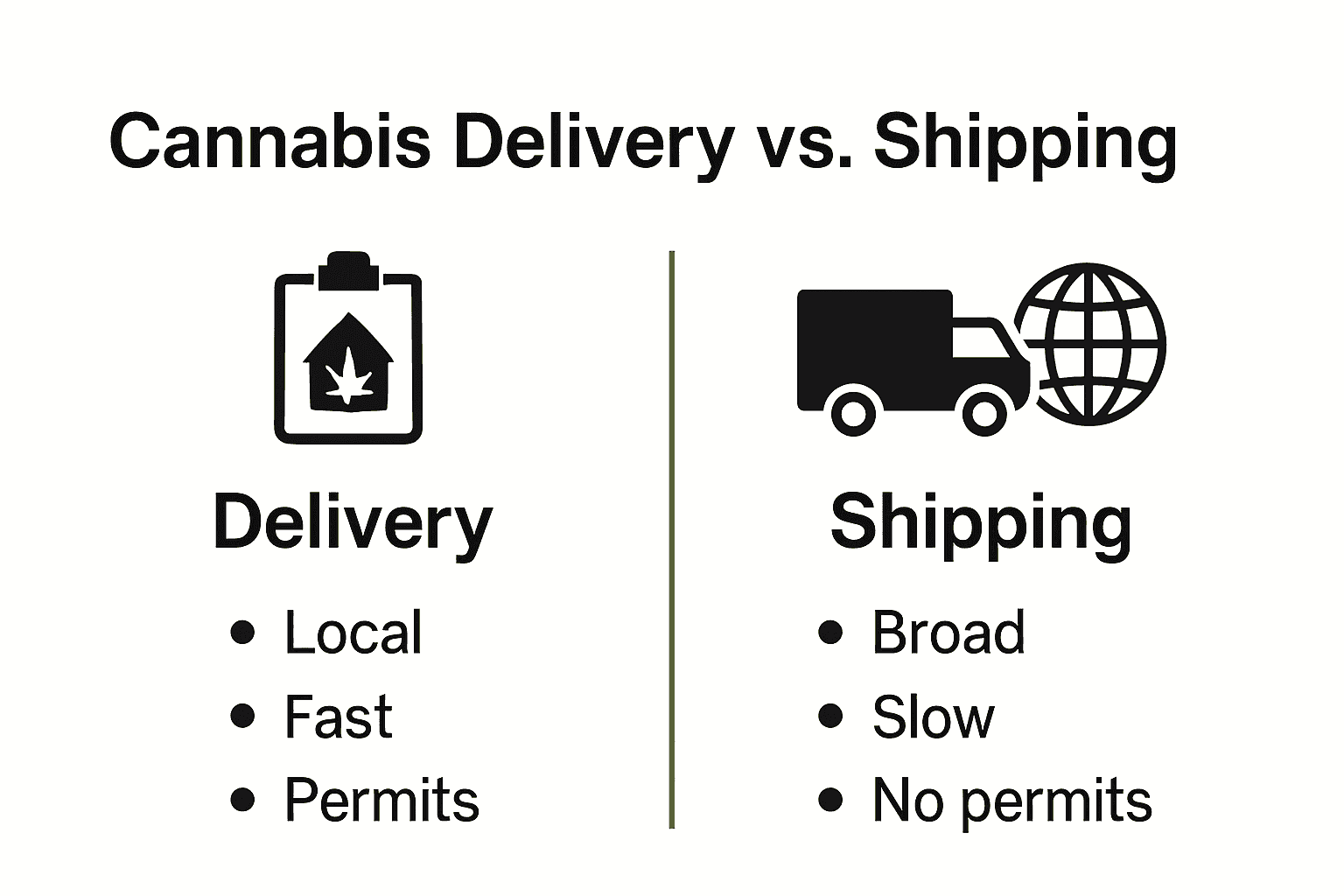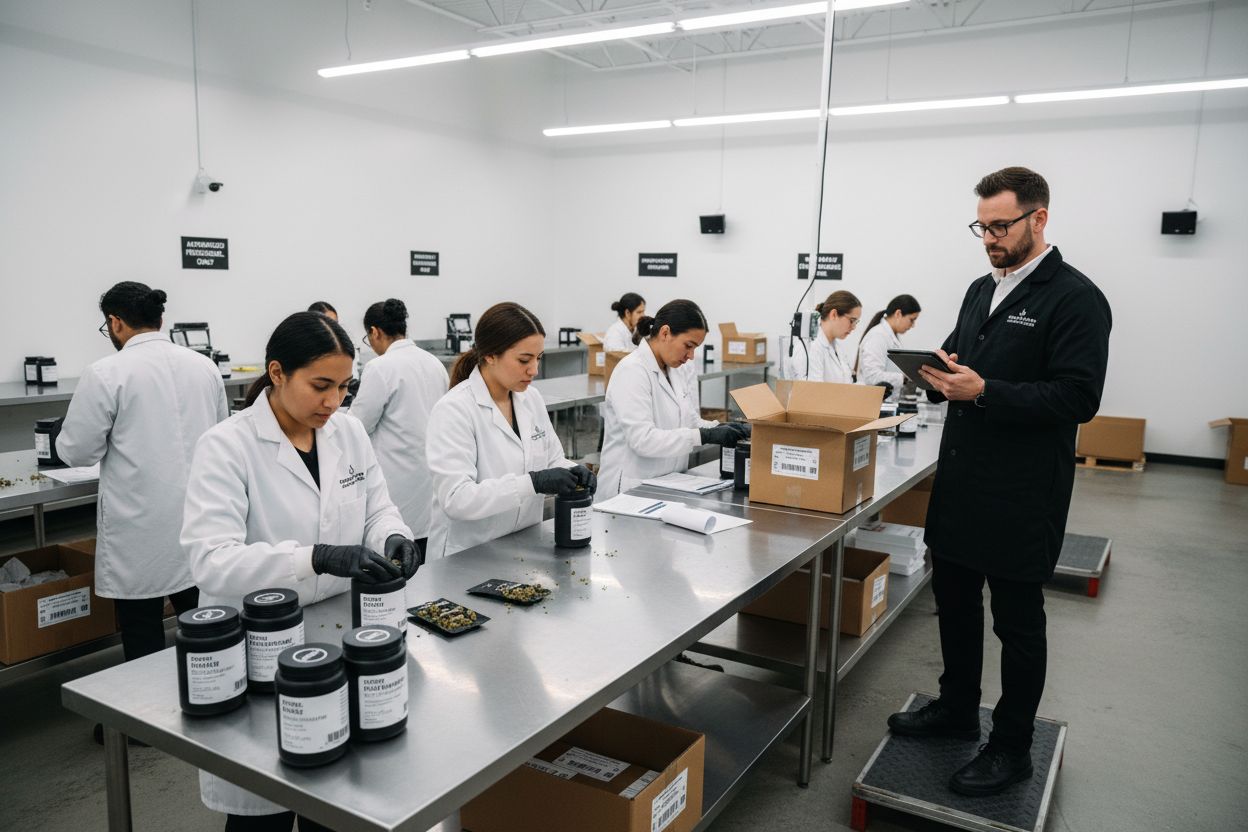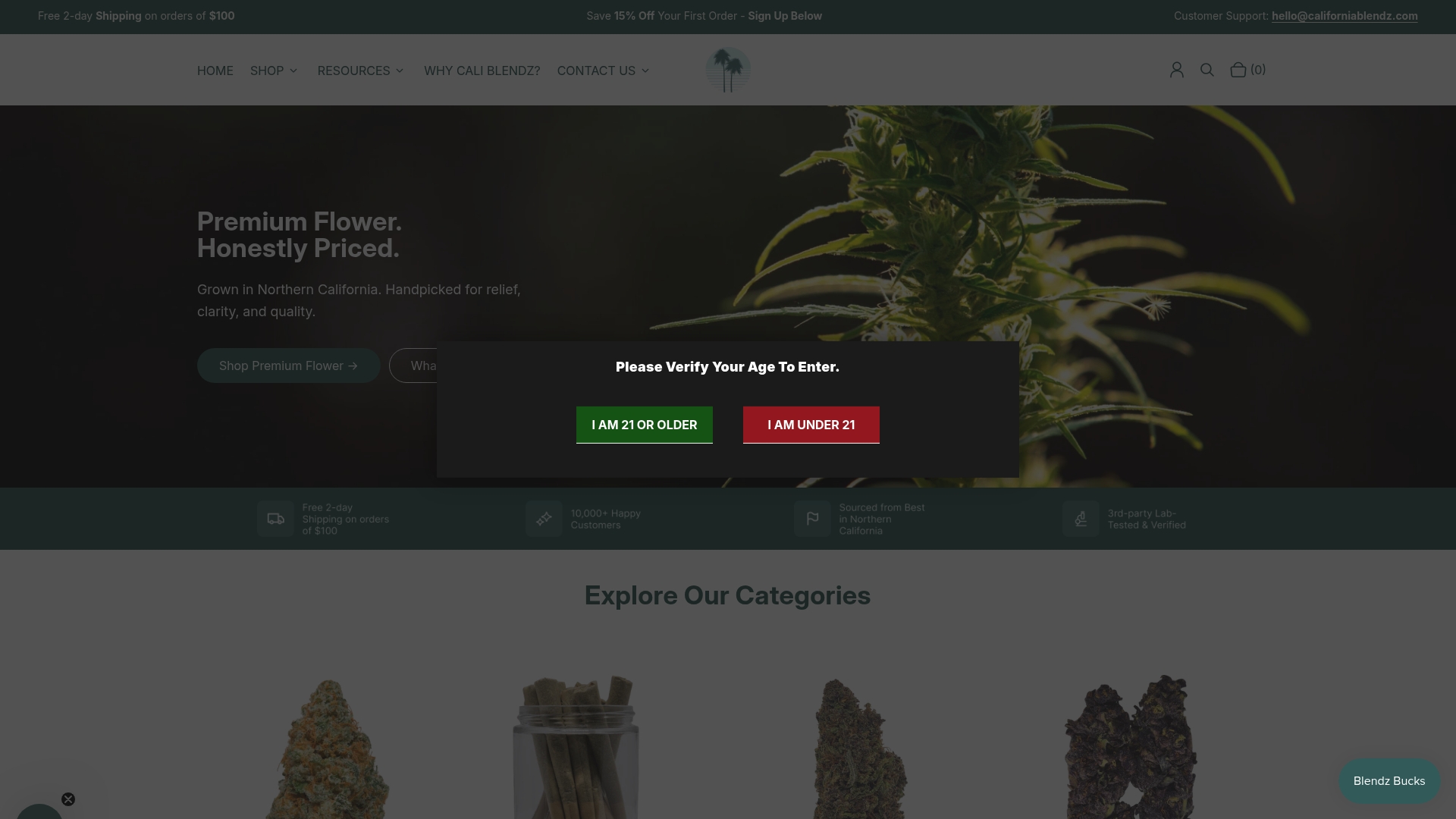Cannabis Delivery and Shipping: Complete Guide
Written by Trevor

Nearly 75 percent of legal cannabis transactions now happen outside of traditional storefronts. This shift highlights how convenience and privacy fuel demand for direct-to-consumer delivery and specialized shipping. As regulations change and services expand across borders, knowing the difference between cannabis delivery and shipping helps buyers and businesses avoid costly mistakes. Clear rules, safe packaging, and strict compliance shape every step, impacting how cannabis moves from licensed sellers to your door.
Key Takeaways
| Point | Details |
|---|---|
| Delivery vs. Shipping | Delivery is localized and immediate, while shipping involves longer distances with complex regulations. |
| Regulatory Landscape | Cannabis transportation regulations vary significantly by region, necessitating careful navigation by consumers and businesses. |
| Specialized Packaging | Proper packaging for cannabis shipping requires impact resistance, tamper-evidence, and child-resistant features to comply with legal standards. |
| Compliance and Risk Management | Businesses must establish robust compliance protocols to mitigate risks associated with regulatory inconsistencies and legal exposure. |
Table of Contents
- Defining Cannabis Delivery And Shipping
- Types Of Cannabis Delivery Services
- Shipping Methods And Packaging Requirements
- Legal Regulations By Region And Country
- Addressing Risks, Liabilities, And Compliance
Defining Cannabis Delivery and Shipping
Cannabis delivery and shipping represent two interconnected methods of getting cannabis products from sellers to consumers, each with unique characteristics and regulatory considerations. At its core, cannabis delivery involves transporting cannabis products directly to a customer’s location, while shipping typically refers to the broader process of legally moving cannabis products across different geographical regions.
According to insights from understanding cannabis shipping laws, delivery and shipping are fundamentally different processes. Delivery is often localized and involves immediate transportation within a specific jurisdiction, whereas shipping can involve more complex logistics, especially when crossing state or international borders. Key differences include:
- Local Delivery: Point-to-point transportation within a defined geographical area
- Shipping: Potentially longer-distance transportation with additional legal and compliance requirements
- Regulatory Oversight: Different rules governing transportation methods
As commercial research indicates, cannabis shipping—particularly for medical or scientific purposes—operates under strict international regulations. These regulations typically require:
- Government-issued permits
- Comprehensive safety documentation
- Compliance with international conventions like the UN Single Convention
Understanding these nuanced differences is crucial for consumers and businesses navigating the complex landscape of cannabis product distribution.
 The legal framework surrounding cannabis transportation continues to evolve, making it essential to stay informed about current regulations and best practices.
The legal framework surrounding cannabis transportation continues to evolve, making it essential to stay informed about current regulations and best practices.
Here’s a comparison of cannabis delivery and shipping characteristics:
| Aspect | Delivery | Shipping |
|---|---|---|
| Scope | Local | Regional/International |
| Speed | Immediate/Same-day | Longer transit times |
| Regulatory Oversight | Local or state rules | Multi-jurisdictional laws |
| Permits Required | Often limited | Government and international |
| Common Uses | Consumer orders Medical |
Scientific samples Bulk sales |
| Packaging Needs | Tamper-evident | Impact-resistant Secure seals |
Types of Cannabis Delivery Services
Cannabis delivery services have evolved into diverse models that cater to different consumer needs and regulatory environments. These services range from traditional retail-based delivery to more innovative approaches like telemedicine-linked distribution and non-profit social club systems. Explore the benefits of buying cannabis online to understand how these delivery mechanisms enhance consumer accessibility.
According to research on global cannabis distribution frameworks, several distinctive delivery models have emerged:
- Local Dispensary Delivery: Direct transportation from licensed retail locations to consumer addresses
- Medical Telemedicine Delivery: Remote prescription and home delivery for patients
- Non-Profit Social Club Distribution: Membership-based models popular in European markets like Germany
In countries like Germany and Switzerland, innovative non-profit cannabis social clubs have pioneered unique delivery approaches. These models typically involve:
- Registered member networks
- Controlled distribution through dedicated clubs
- Options for home cultivation pickup
- Telemedicine-linked access channels
Research from international cannabis regulatory studies highlights the significant variation in delivery systems worldwide. Some regions, like Portugal, have decriminalized personal use, creating more flexible distribution frameworks, while others maintain strict prohibitions that essentially eliminate legal delivery options. This global diversity underscores the complex legal landscape surrounding cannabis transportation and access.
Shipping Methods and Packaging Requirements
Navigating the complex world of cannabis shipping methods requires understanding intricate legal and logistical challenges. Learn more about cannabis product shipping laws to ensure compliance and safe transportation of cannabis products. Most major couriers like DHL, FedEx, and UPS have strict prohibitions against cannabis shipping, making specialized logistics critical for successful delivery.
Specialized packaging is paramount in cannabis shipping, with rigorous requirements designed to protect product integrity and ensure regulatory compliance. According to packaging research, essential packaging features include:
- Impact-resistant containers
- Airtight seals to prevent moisture contamination
- UV-protective materials
- Tamper-evident designs
- Child-resistant mechanisms
Detailed labeling becomes crucial, typically requiring:
- Precise THC/CBD content measurements
- Comprehensive batch tracking information
- Complete third-party testing documentation
- Clear handling and storage instructions
International shipping presents additional complexity. Research indicates that while some regions like parts of Canada permit regulated cannabis shipping, global transportation remains heavily restricted. Temperature control, discretion, and maintaining product potency throughout transit are critical considerations that demand specialized shipping protocols and expert handling.

Legal Regulations by Region and Country
Cannabis delivery regulations vary dramatically across different global jurisdictions, creating a complex landscape of legal frameworks that consumers and businesses must carefully navigate. Explore our guide on understanding cannabis shipping laws to gain deeper insights into these intricate regional differences.
Recent international developments highlight the dynamic nature of cannabis regulation. According to recent reports, countries are rapidly adjusting their legal approaches to cannabis distribution. For instance:
- Germany: In October 2025, implemented strict regulations prohibiting mail-order cannabis
- Thailand: Proposing tighter controls on cannabis sales after initial decriminalization
- United States: Continues to have varying state-level regulations
Specific regional changes demonstrate the evolving regulatory environment:
- Germany now requires in-person doctor consultations
- Distribution limited strictly to physical pharmacies
- Increased enforcement against unauthorized distribution channels
In Thailand, authorities are responding to emerging challenges by proposing more stringent rules. After decriminalizing cannabis in 2022, the government is now focusing on:
- Implementing prescription requirements
- Enhancing enforcement at airports
- Monitoring mail systems to prevent unauthorized distribution
These international examples underscore the complex and rapidly changing landscape of cannabis delivery regulations, emphasizing the need for consumers and businesses to stay informed about current legal frameworks.
Addressing Risks, Liabilities, and Compliance
Cannabis delivery compliance represents a complex landscape of legal and operational challenges that demand meticulous attention from businesses and consumers. Read our detailed guide on understanding cannabis shipping laws to navigate these intricate regulatory requirements effectively.
In the rapidly evolving cannabis industry, businesses face significant risks associated with inconsistent regulatory standards. According to recent legal research, key compliance challenges include:
- Testing Inconsistencies: Varying state-level testing protocols
- Legal Exposure: Potential for recalls and financial disputes
- Regulatory Complexity: Navigating multi-jurisdictional requirements
Businesses must implement comprehensive risk mitigation strategies:
- Develop robust internal compliance protocols
- Maintain rigorous documentation
- Invest in standardized testing frameworks
- Continuously monitor regulatory changes
The consequences of non-compliance can be severe. Recent investigations reveal that inconsistent testing standards can lead to:
- Unexpected product recalls
- Potential legal disputes
- Significant financial losses
- Damage to brand reputation
Successful cannabis delivery operations require a proactive approach to risk management. This means staying ahead of regulatory changes, investing in comprehensive compliance infrastructure, and maintaining transparent, documented processes that can withstand intense regulatory scrutiny.
Confident Cannabis Delivery Starts with Trusted Products
Tired of facing confusing shipping rules, inconsistent quality, or uncertain legal compliance when shopping for cannabis products? Our complete guide highlights the challenges of secure delivery, strict regional shipping laws, and the need for reliable packaging and accurate labeling. At California Blendz, we take the guesswork out of cannabis delivery so you can focus on enjoying premium, fully compliant products sourced from the heart of California. Dive into our curated CBD Edibles collection, which showcases our commitment to transparent lab testing and regulatory adherence.

Experience the difference of shopping with a team dedicated to both education and excellence. Whether you seek dependable shipping practices or want to explore exclusive community offerings with the Emerald Tier Society, now is the time to shop with confidence at California Blendz. Discover your new standard for safe, high-quality cannabis delivery today.
Frequently Asked Questions
What is the difference between cannabis delivery and shipping?
Cannabis delivery refers to the localized transportation of cannabis products directly to a customer’s location, while shipping involves transporting products over longer distances, often across state or international borders, with more complex legal regulations.
What are the types of cannabis delivery services?
There are several types of cannabis delivery services, including local dispensary delivery, medical telemedicine delivery, and non-profit social club distribution. Each model caters to different consumer needs and regulatory environments.
What packaging requirements are necessary for cannabis shipping?
Cannabis shipping requires specialized packaging that includes impact-resistant containers, airtight seals, UV-protective materials, tamper-evident designs, and child-resistant mechanisms, along with detailed labeling that includes THC/CBD content and safety information.
What are the compliance challenges associated with cannabis delivery?
Major compliance challenges include inconsistent state-level testing protocols, potential legal exposure from recalls and disputes, and the complexity of navigating multi-jurisdictional regulations. Businesses must develop robust compliance protocols to mitigate these risks.








